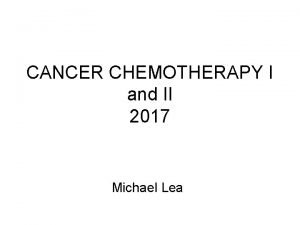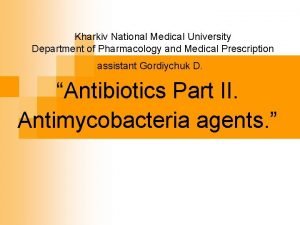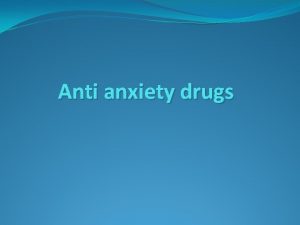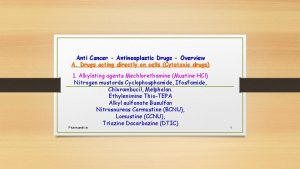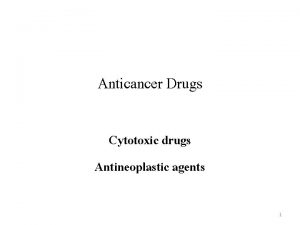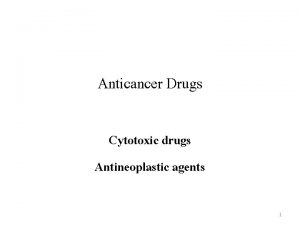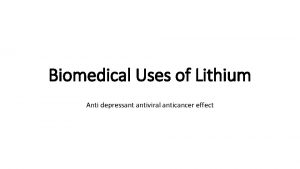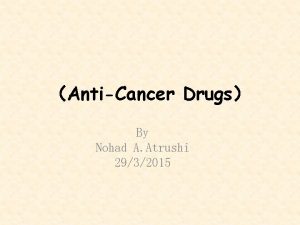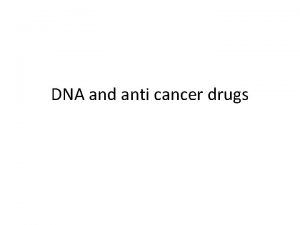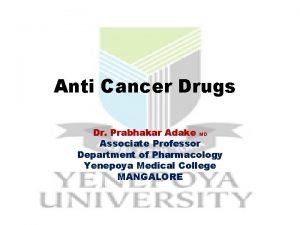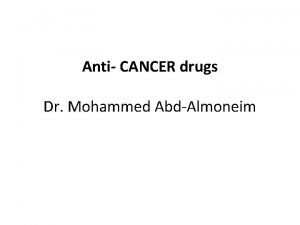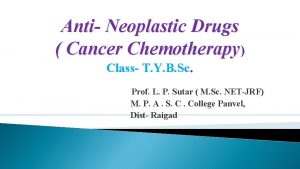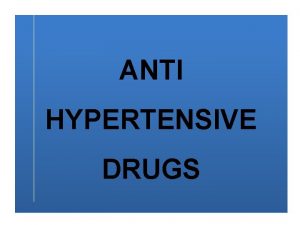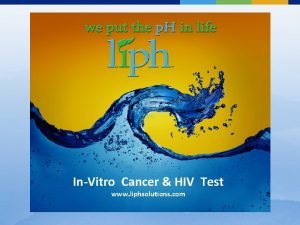Anticancer Drugs Introduction Anti cancer drugs either kill



























- Slides: 27

Anticancer Drugs

Introduction Anti cancer drugs either kill cancer cell or modify their growth. The drugs attack is directed to DNA or against metabolic site it to cells that essential to cell replications. Unfortunately, most currently available anticancer drugs do not specifically recognize neoplastic cells but, rather, affect all kinds of proliferating cells both normal and abnormal.

Classifications of anticancer drugs 1 - Cytotoxic Drugs a- Antimetabolites b- Antibiotics c- Alkylating Agents d- Microtubule Inhibitors 2 - Steroid , Hormones and their Antagonists. 3 - Targets drugs 4 - others


Common adverse effects: Severe vomiting, stomatitis, bone marrow suppression, and alopecia occur to a lesser or greater extent during therapy with all antineoplastic agents. Some toxicities, such as myelosuppression that predisposes to infection, are common to many chemotherapeutic agents. cardiotoxicity with doxorubicin and pulmonary fibrosis with bleomycin. The duration of the side effects varies widely. For example, alopecia is transient, but the cardiac, pulmonary, and bladder toxicities are irreversible.


Antimetabolites Antimetabolites: Methotrexate 6 -Mercaptopurine 5 -Fluorouracil Cytarabine Gemcitabine these drugs are structurally related to the normal compound that exist within the cells

Methotrexate (MTX) is structurally related to folic acid and acts as an antagonist of that vitamin by inhibiting (DHFR) the enzyme that converts folic acid to its active, coenzyme form, tetrahydrofolic acid. The inhibition of DHFR can only be reversed by Leucovorin, or folic acid. Therapeutic uses: MTX, usually in combination with other drugs, is effective against acute lymphocytic leukemia, choriocarcinoma, Burkitt's lymphoma in children, breast cancer, and head and neck carcinomas. In addition, low-dose MTX is effective as a single agent against certain inflammatory diseases, such as severe psoriasis and rheumatoid arthritis as well as Crohn's disease.

Methotrexate

Methotrexate Adverse effects: Commonly observed toxicities: In addition to nausea, vomiting, and diarrhea, the most frequent toxicities occur in tissues that are constantly renewing. Thus, MTX causes myelosuppression, erythema and rash. Some of these adverse effects can be prevented or reversed by administering leucovorin which is taken up more readily by normal cells than by tumor cells. Doses of leucovorin must be kept minimal to avoid possible interference with the antitumor action of MTX.

Mercaptopurine 6 -MP is used principally in the maintenance in acute lymphoblastic leukemia. 6 -MP are also beneficial in the treatment of Crohn's disease.

Mercaptopurine Adverse effects: Bone marrow depression is the principal toxicity. Side effects also include anorexia, nausea, vomiting, and diarrhea. Fluorouracil: FU is employed primarily in the treatment of slowly growing solid tumors (for example, colorectal, breast, ovarian, pancreatic, and gastric carcinomas). Because of its severe toxicity to the GI tract, 5 -FU is given IV or, in the case of skin cancer, topically

Antibiotics Dactinomycin Doxorubicin and daunorubicin Bleomycin These drugs are very potent anticancer drugs effective against Wilms' tumor and childhood rhabdomyosarcoma. Dactinomycin : Dactinomycin is used in combination with surgery and for the treatment of Wilms' tumor. In combination with MTX, dactinomycin is effective in the treatment of gestational choriocarcinoma.

Dactinomycin The drug, administered IV, distributes to many tissues but does not enter the CSF The drug is minimally metabolized in the liver. Adverse effects: The major dose-limiting toxicity is bone marrow depression. The drug is immunosuppressive. Other adverse reactions include nausea, vomiting, diarrhea, stomatitis. Extravasation during injection produces serious problems.

Doxorubicin and Idarubicin Doxorubicin is one of the most important and widely used anticancer drugs. It is used in combination with other agents for treatment of sarcomas and a variety of carcinomas, including breast and lung, as well as for treatment of acute lymphocytic leukemia and lymphomas. All these drugs must be administered IV, because they are inactivated in the GI tract.

Doxorubicin and idarubicin Extravasation is a serious problem that can lead to tissue necrosis. They do not penetrate the blood-brain barrier or the testes. All these drugs undergo extensive hepatic metabolism. The bile is the major route of excretion, and the drug dose must be modified in patients with impaired hepatic function. Some renal excretion also occurs, but the dose generally need not be adjusted in patients with renal failure. Because of the dark red color of the Anthracycline drugs, the veins may become visible surrounding the site of infusion, and the drugs also impart a red color to the urine.

Doxorubicin and idarubicin Adverse effects: Irreversible, dose- dependence cardiotoxicity. doxorubicin increases congestive heart failure. Doxorubicin cause transient bone marrow suppression, and GI tract disturbances. Increased skin pigmentation is also seen. .

Alkylating Agents Cyclophosphamide and ifosfamide These agents have a broad clinical spectrum, such as Burkitt's lymphoma and breast cancer. Non-neoplastic disease entities, such as nephrotic syndrome and difficult rheumatoid arthritis. cyclophosphamide and ifosfamide can be administered by the oral route. After oral administration, minimal amounts of the parent drug are excreted into the feces or into the urine

Cyclophosphamide and ifosfamide Adverse effects: The most prominent toxicities of both drugs (after alopecia, nausea, vomiting, and diarrhea) are bone marrow depression, especially leukocytosis, and hemorrhagic cystitis, which can lead to fibrosis of the bladder. A fairly high incidence of neurotoxicity has been reported in patients on high-dose ifosfamide.

Vincristine and vinblastine They are two important anticancer alkaloids , these two drugs differ in their use and adverse effect and there is no cross resistance between the two though they are chemically related. Uses : For treatment of acute lymphoblastic leukemia in children, Wilms‘ tumor, Ewing's soft-tissue sarcoma, Hodgkin's and non. Hodgkin's lymphomas Intravenous injection of these agents leads to rapid cytotoxic effects and cell destruction. These alkaloids are concentrated and metabolized in the liver They are excreted into bile and feces. Doses must be modified in patients with impaired hepatic function or biliary obstruction.

Vincristine and vinblastine Adverse effects: phlebitis or cellulitis, if the drugs extravagate during injection, as well as nausea, vomiting, diarrhea, and alopecia. VBL is a more potent myelosuppression than VX, where as peripheral neuropathy. Constipation is more frequently encountered with VX, which can also cause inappropriate antidiuretic hormone secretion. The anticonvulsants can accelerate the metabolism of VX, whereas the antifungal drugs can slow its metabolism.

Steroid Hormones and Their Antagonists Prednisone & Tamoxifen Prednisone is a potent, synthetic, anti-inflammatory corticosteroid. The use of this compound in the treatment of lymphomas when it was observed that patients with Cushing's syndrome, which is associated with hypersecretion of cortisol, have lymphocytopenia and decreased lymphoid mass. Prednisone is primarily employed to induce remission in patients with acute lymphocytic leukemia and in the treatment of both Hodgkin's and non-Hodgkin's lymphomas.

Prednisone is readily absorbed orally. Like other glucocorticoids Adverse effects: Prednisone has many of the adverse effects associated with glucocorticoids. It can predispose to infection (due to its immunosuppressant action) and to ulcers and pancreatitis. Other effects include hyperglycemia, cataract formation, glaucoma, osteoporosis, and change in mood (euphoria or psychosis).

Tamoxifen is an antiestrogen. is used for first-line therapy in the treatment of estrogen receptor positive breast cancer. Tamoxifen is effective on oral administration. It is partially metabolized by the liver. Adverse effects: Side effects caused by tamoxifen are similar to the effects of natural estrogen, including hot flashes, nausea, vomiting, skin rash, vaginal bleeding, and discharge Hypercalcemia may occur. Tamoxifen can also lead to increased pain if the tumor has metastasized to bone. Tamoxifen has the potential to cause endometrial cancer.

Monoclonal Antibodies Trastuzumab. (breast cancer). Rituximab. (posttransplant lymphoma and in chronic lymphocytic leukemia. ) Bevacizumab. (colorectal cancer). Cisplatin and Oxaliplatin Cisplatin has found wide application in the treatment of solid tumors, such as metastatic testicular carcinoma, ovarian carcinoma , bladder carcinoma. Oxaliplatin is showing excellent activity against advanced colorectal cancer.

Cisplatin and Oxaliplatin Adverse effects: Severe, persistent vomiting occurs for at least 1 hour after administration of cisplatin and may continue for as long as 5 days. The major limiting toxicity is dose-related nephrotoxicity. hypocalcemia usually occur concurrently. Other toxicities include ototoxicity with high-frequency hearing loss and tinnitus, mild bone marrow suppression, some neurotoxicity and hypersensitivity reactions ranging from skin rashes to anaphylaxis. Patients concomitantly receiving aminoglycosides are at greater risk for nephrotoxicity and ototoxicity.

L- Asparaginase The form of the enzyme used chemotherapeutically is derived from bacteria. L- Asparaginase is used to treat childhood acute lymphocytic leukemia in combination with VX and prednisone. The enzyme must be administered either IV or intramuscularly, because it is destroyed by gastric enzymes. Toxicities include a range of hypersensitivity reactions (because it is a foreign protein), a decrease in clotting factors, liver abnormalities, pancreatitis, and coma due to ammonia
 Anticancer drugs classification
Anticancer drugs classification Anticancer drugs classification
Anticancer drugs classification Anti a anti b anti rh blood type
Anti a anti b anti rh blood type Anthracyclines
Anthracyclines Anti diarrheal drugs list
Anti diarrheal drugs list Classification of sympatholytic drugs
Classification of sympatholytic drugs Theophylline mechanism of action
Theophylline mechanism of action Aminoglycoside
Aminoglycoside Antidiuretic drugs
Antidiuretic drugs To kill a mockingbird symbols
To kill a mockingbird symbols Either or plural or singular
Either or plural or singular Example of informal social control
Example of informal social control Reference words
Reference words False equivalence fallacy
False equivalence fallacy Too either neither
Too either neither Data map haskell
Data map haskell Anecdotal fallacy
Anecdotal fallacy Independent vs dependent variable
Independent vs dependent variable Or vs nor
Or vs nor Wetland ecosystem definition
Wetland ecosystem definition No a nor b
No a nor b Identify each statement as either true or false.
Identify each statement as either true or false. All every each
All every each Either or dichotomy
Either or dichotomy Singular and plural i we you they
Singular and plural i we you they Compound subject
Compound subject Sam likes hamburgers
Sam likes hamburgers Subject verb agreement examples
Subject verb agreement examples
